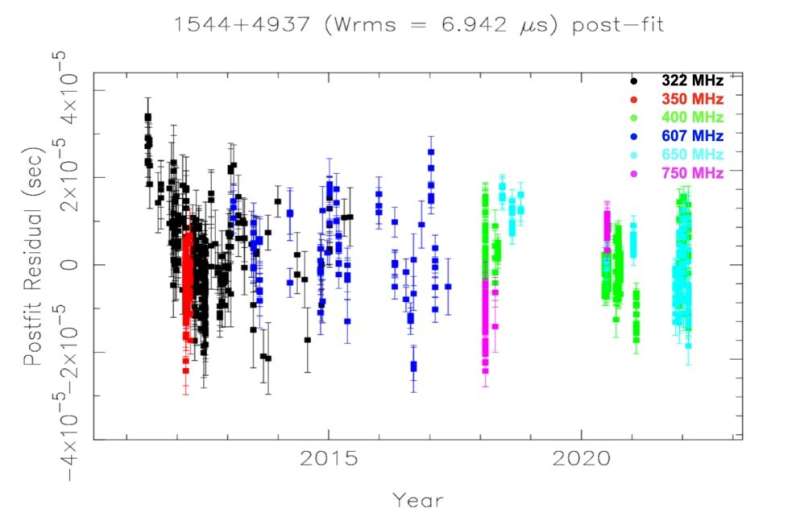December 6, 2022 report
'Black widow' PSR J1544+4937 investigated in detail

Indian astronomers have performed long-term radio observations of a "black widow" millisecond pulsar known as PSR J1544+4937. Results of the observational campaign, published November 25 on the arXiv pre-print server, shed more light on the properties of this pulsar.
The most rapidly rotating pulsars, those with rotation periods below 30 milliseconds, are known as millisecond pulsars (MSPs). Researchers assume that they are formed in binary systems when the initially more massive component turns into a neutron star that is then spun up due to accretion of matter from the secondary star.
A class of extreme binary pulsars with semi-degenerate companion stars is dubbed "spider pulsars." These objects are further categorized as "black widows" if the companion has extremely low mass (less than 0.1 solar masses), while they are called "redbacks" if the secondary star is heavier.
Discovered by the Giant Meterwave Radio Telescope (GMRT) in 1991, PSR J1544+4937 is a black widow MSP with a spin period of 2.16 milliseconds. The pulsar is in a binary system with an orbital period of 2.9 hours orbiting around a low-mass companion star (with a mass of at least 0.017 solar masses).
With the aim of unveiling more insights into the properties of PSR J1544+4937, a team of astronomers led by Sangita Kumari of the Tata Institute of Fundamental Research in India has conducted a 11-year monitoring campaign of this source using GMRT and the Green Bank Telescope (GBT).
"The majority of the observations reported in this paper were performed with the GMRT, which is a radio interferometric array consisting of 30 dishes, each 45 meters in diameter.... In 2012, we used the Green Bank Telescope (GBT) to make several observations of PSR J1544+4937, in order to help determine the orbit of the system," the researchers wrote.
First of all, the team measured the total proper motion of PSR J1544+4937, which was found to be about 10.14 mas per year. This allowed the astronomers to calculate the 2−D transverse velocity of this pulsar using two galactic electron density models, namely NE2001 and YMW16. This velocity turned out to be at a level of 140 and 58 km/s for NE2001 and YMW16, respectively. The distance to PSR J1544+4937 is estimated to be 3,900 (NE2001) or 9,450 light years (YMW16).
The dispersion measure of PSR J1544+4937 was measured to be approximately 23.22 pc/cm3 and its characteristic age was estimated to be some 42 billion years. The study also found that the pulsar has a surface magnetic field at a level of 42 million Gauss and that the energy loss rate of this source is about 12 decillion erg/s. The mass of the companion star was calculated to be 0.0196 solar masses.
The research detected temporal variations of dispersion measure of PSR J1544+4937. Moreover, the results also indicate frequency-dependent dispersion measure, variations of which, according to the authors of the paper, could arise due to spatial electron density variations in the interstellar medium.
More information: Sangita Kumari et al, Decade Long Timing Study of the Black Widow Millisecond Pulsar J1544+4937, arXiv (2022). DOI: 10.48550/arxiv.2211.14107
Journal information: arXiv
© 2022 Science X Network




















